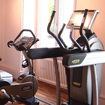How active is your partner?
Elementary level
Description
Materials
Main Aims
-
To provide accuracy in simple present positive/negative sentences
Subsidiary Aims
-
To provide review of Simple present tense in the context of free time activities
Procedure (29-43 minutes)
The teacher will start the session with some general warm-up questions targeting the free time activities like: -Do you listen to music? -Do you play tennis? While asking these questions the teacher must promote short answers like: -Yes,I do.OR No,I don't. Following these questions,one of the sentences will be put on the board,and after repeating the sentence for a few times some choral substitution drills followed by individual spot checks will be carried out.
Pointing at one of the students, the teacher will say "He reads books."and pointing to another student says "She doesn't go dancing."Here again the teacher will lead the sentences into substitution drills,however,one of the substitution drills will focus on the subject change like: I go/He goes,The other one will be about making sentences with the third person singular.
The teacher will have the students ask him questions about his/her free-time activities,he/she will respond to the questions with short answers using "Yes,I do." or "Yes,sometimes." "No,I don't".Then the teacher will write "Yes,I do." and "No,I don't." on the board and will also write "Yes,sometimes."between the other mentioned short answers.Using the acting and gestures the teacher will show that "Yes,sometimes." is weaker than "Yes,I do." Following the short-answers,the teacher will write three similar adjectives on the board and add intensifiers to them to make the lesson clear.First "very adj" then "quite adj" and then "not very adj".examples and drills will follow the lesson.
The teacher explains that the students will have an activity and that they should make guesses about their partners and then to ask questions from their partners about their guesses and at the end make a comment about their partner.To be more clear the teacher will give an outline of the game on the board.The teacher distributes the hand-outs.The teacher pairs the students up.It is very important to pair the students in a way that they have the least information about each other.Then they will be asked to make guesses about their partner WITHOUT talking to their partner using the prompts in hand-outs.Then students will be asked to interview their partners and make a comment about how active their partner is.At the end they will give a whole class feed-back.

